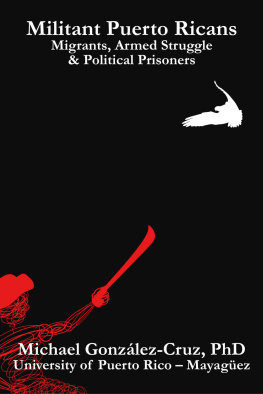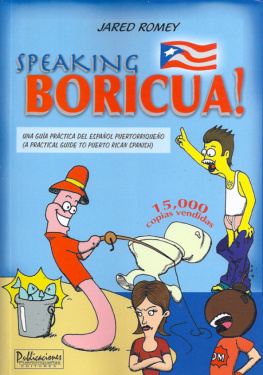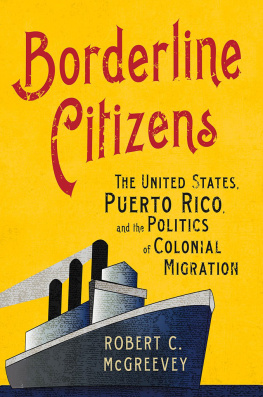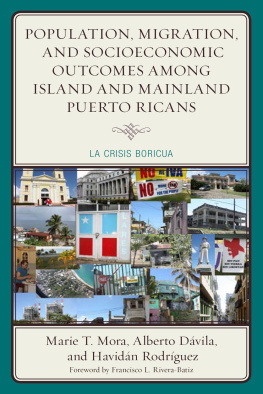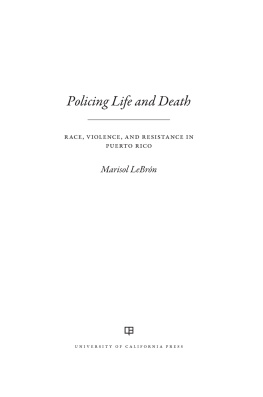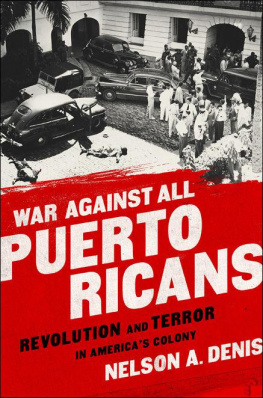San Juan, P.R. 2020
Cover design: Albert R. Gonzlez Marn
Introduction
Facing discrimination from fellow members in unions, organizations, and political parties, Militant Puerto Ricans tells the story of how Puerto Ricans in the United States participated in traditional politics, while creating clandestine organizations. By 1965, Puerto Ricans had created over six-hundred different political and communal organizations, with different approaches, methods, and tactics. Many organizations focused on improving conditions in Puerto Rican communities, and others aimed at freeing Puerto Rico from its colonial status. Militant Puerto Ricans focuses on the formation and the strategies of the Young Lords Party (YLP), the Puerto Rican Socialist Party (PSP), the Puerto Rican National Left Movement (or the Comit [MINP]), the Puerto Rican Student Union (PRSU), the Fuerzas Armadas de Liberacin Nacional (FALN), the Nationalist Party (PN) and the Puerto Rican Independence Party (PIP).
Militant Puerto Ricans tells the story of how leaders and activists who belonged to these organizations, constantly travelled between Puerto Rico and the U.S., strengthening the bonds between activists and organizations in and outside Puerto Rico. Additionally, Militant Puerto Ricans tells us the story of how clandestine organizations, such as the FALN and the Macheteros, organized to make others conscious about Puerto Ricos colonial status.
Militant Puerto Ricans timeline starts in 1868, when Puerto Ricans rebelled against the Spanish colonial government in El Grito de Lares. After el grito , rebel bands in Puerto Rico continued their resistance by assaulting landowners, burning their fields, and destroying credit books. These bands were known as the tiznados, who despite their efforts, did not organize into a large-scale revolutionary movement. Puerto Rico would not see a large revolutionary movement until the 1930s, when Pedro Albizu Campos was elected the president of the Nationalist Party, a working-class movement that threatened corporate and colonial powers.
The U.S. fought the Nationalist Party by implementing a Gag Law, they tortured and executed Nationalists, and shot peaceful protesters. Facing violent oppression from the colonial government, the armed struggle became clandestine. The Chicago-based Armed Forces of National Liberation (FALN) and the Boricua Popular Army (EPB) [otherwise known as the Macheteros] took command. They attacked and destroyed banks, oil pipelines, military equipment, and federal offices. Their aim was not to overthrow the government, but to protest Puerto Ricos colonial status.
The FBI and Puerto Rican polices tactics against activists were vicious and brutal. Besides their assassinations of activists without due process, one of the most shocking facts this chapter reports on was how a bomb was planted in the Puerto Rican Socialist Partys daycare center. It was only after 150,000 dossiers on independence supporters were revealed to the public in the late 1980s, that the FBI scaled back its vicious assassination campaign. Instead, their tactics shifted to harassment of key individuals, infiltration of activist organizations and a massive media brainwashing campaign to demonize leftist militant tactics.
Militant Puerto Ricans concludes with a chapter on the lives of Pedro Albizu Campos revolutionary disciples. In 1999, the U.S. released twelve Puerto Rican political prisoners after a massive protest took place in the island. Puerto Rico received them with hugs, ovations, and parades. Michael Gonzlez-Cruz tells us that these revolutionaries were radicalized by the tragic circumstances of their nation, their communities, and their reality. In the United States, many became radicalized when they witnessed the police and FBI violently repress the Black Panther Party.
Puerto Ricans who have been born and raised in the United States have faced racism and discrimination to this day. Our militants have fought for liberation, occupied buildings, rescued their history, created culture, and fought their oppressors to achieve a justice that has been denied to them for centuries.
This is their story.
I
Puerto Rican Settlement: 1865-1916
Between 1865 and 1916, there was a slow migratory flow from Puerto Rico to the United States that has not been completely documented. This period encompasses three major events: the 1868 insurrection against Spain, which caused the first settlement in New York City, the 1898 U.S. invasion of Puerto Rico, that caused hundreds of Puerto Ricans to migrate to Cuba, the Dominican Republic and Mexico during the first five years of military government on the Island, and the First World War. I will not go into detail about the last period, but it is important to point out that it took place along with colonial occupation and it is possible that immigrants joined the political exiles already established in New York. The work on Puerto Rican immigration documents that there were three exoduses or mass migration periods: the first in 1917, the second in 1950 and the third in 1970.
After 1865, most Puerto Rican immigrants were political exiles and or members or sympathizers of the Junta Revolucionaria Cubana. Dozens of professionals migrated by force or voluntarily; most of them were liberals opposed to the Spanish regime on the Islands and some were, in fact, members of this anti-imperialist party. Among the most noteworthy of them were Roberto H. Todd, Eugenio Mara de Hostos and Ramn Emeterio Betances.
The memoirs of tobacco labor leader, Bernardo Vega, offer the best description and analysis of this period including the foundation of the Barrio in New York City (Andru-Iglesias 1977).
The first physical settlements were located on the eastern side of lower and upper Manhattan. In the same places they lived, they founded the first native businesses: boarding houses, eateries, barbershops, medical and legal offices, and cigar factories. The tobacco workers had an advanced political formation; there were anarchist and independent socialist leaders among them. This group of people constituted the first Puerto Rican colony in New York.
According to Bernardo Vega, Puerto Ricans were part of the dynamic Hispanic community that settled in the U.S. at the end of the 19th century. Starting in 1890, there were more than ten cultural, political and workers associations that, along with the Partido Revolucionario Cubano-Puertorriqueo, supported liberation of the Antilles from Spanish rule. The Artisans League, mainly tobacco workers, and the Antillean League, led by Cuban and Puerto Rican women, served as propaganda and financial centers for the cause of independence. Its important to point out that the League of Antillean Women was a multi-racial organization where mulatto, black and white women joined in one struggle (Andru-Iglesias 1977). The solidarity of artisans and male and female tobacco workers continued into the 20 th century when these groups joined the struggle against American imperialism.
When the Puerto Rico Section of the Partido Revolucionario Cubano was created (1882), tobacco workers criticized the fact that there were no representatives of the working class in the party leadership. Many anarchist workers were opposed on principle to both bourgeois independence and American annexation. Their argument was that the national liberation movement and later, the country, had to be led by workers. Puerto Rican Labor leaders in New York also denounced Santiago Iglesias Pantn, socialist and pro-statehood leader from the American Federation of Labor, because he did not condemn racism and discriminatory practices within the union. Newspapers such as The Puerto Rico Herald and Patria and Puerto Rican workers organizations such as La Resistencia and Unin Internacional amplified the level of the political debates beyond the struggle for independence to include class struggle and racism in their positions (Andru-Iglesias 1977).

